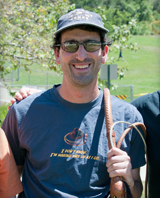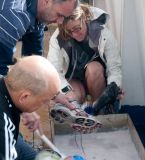
-CIA- World Factbook
-Cool Antarctica
-Discovering Antarctica
-FrankHurley.org

Laird's Bio

Follow Laird at
RunLairdRun.com

Support One of
Laird's Charities
Chapter 9 | Chapter 10 | Chapter 11

Back to 1911. Frustratingly to Amundsen, Scott became more famous (at least initially) for dying on the way back from the Pole than for achieving it. Many researchers and historians attribute this to the end of the Victorian Age than anything Scott did. In fact, Scott is widely criticized for bungling his attempt for the pole. Any modern biography faults him for bad planning and bad execution. Yet, four days after learning of his death, the British nation simultaneously held a public memorial at Westminster Abbey and instructed all schools to read a story of Scott to their students. Due to the nature of communications, this occurred in 1914 – he had already been dead for 2 years. Scott was lauded as being what every true "Englishman" was meant to be: Self-sacrificing and doing it for the "Empire."
What are some of the things Scott did wrong? To reach the pole, it is important to do two things well: One, ensure you and your supplies get to the pole, and two, ensure you have the supplies to get back. Scott messed up both. For transportation, he tried to use horses. Horses hate the cold snow, they aren't adapted to pulling sledges great distances (they do well in short distances) and if you try to feed them horse meat, they won't eat it. Amundsen used dogs. They don't mind the cold, can pull sleds etc and don't care what they eat. In fact, brutal as it sounds, Amundsen planned his supplies to include killing the dogs he didn't need for food for the other dogs. Horses, according to Scott were more noble; true perhaps, but nobility doesn't save your life.
In terms of supplies, the key in reaching the pole is to take all the supplies you need, and you create depots as you go in the snow to serve as provisioning stations. This way, you don't need to schlep the stuff all the way and back. Given the cold, it was easy to keep food from spoiling. Amundsen left his supplies at equal intervals between depots - 1 drop for ever degree of latitude. Scott haphazardly set up his camps. (They used different routes and never encountered each other.) So, when stumbling back from the Pole, deflated to have found the Norwegian flag flying when he arrived, he could not locate his supplies. Ultimately, he and his 4 partners died 11 miles from relief. This poor planning and the untimely arrival of a blizzard led to his death. Climbers in the Himalaya today are very aware of these lessons, and in fact many disasters that happen there are because of poor provision planning.
While I have no delusions of grandeur about being hailed as a hero, just coming to Antarctica is an amazing feat for which I feel very fortunate. Protecting the environment is key when you are down here, and in fact we have to have our clothes vacuumed and our shoes washed to make sure we don't bring any foreign plant material onto the continent. Only two types of vascular plants even exist in Antarctica, so we don't want to add to the count. We even clean our boots between landings so as not to move contaminants from one area of the White Continent to another.
But everyone I have told about this event, or whenever I post on Facebook or RunLairdRun.com, someone new comes out to say how cool this adventure sounds. Ultimately, if there is any connection between this race and the race for the pole 100 years ago, the spirit of adventure links me to Mawson, Shackleton, Scott and Amundsen. That's a super cool group to be part of - even if only in my mind. I am also very happy to be sharing this with people like Les, Tim, Alexis, Martin and Loree.
Next chapters - the marathon itself! Check back in a few days!
Back to the Top
Chapter 9 | Chapter 10 | Chapter 11



